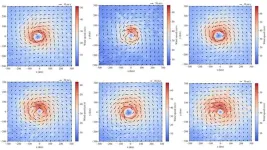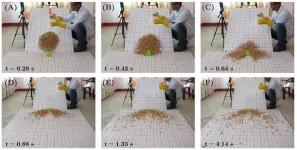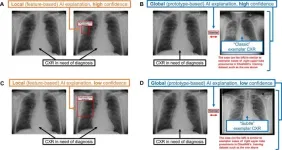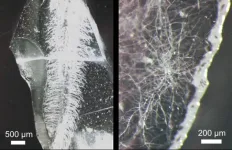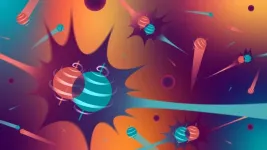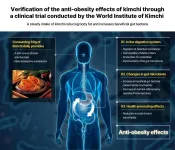(Press-News.org) Viruses are lean, mean, infection machines. Their genomes are tiny, usually limited to a handful of absolutely essential genes, and they shed extra genomic deadweight extremely fast.
Usually.
Coronaviruses, including SARS-CoV-2 (the virus that causes COVID-19), appear at first glance to be an exception. They have some extra “accessory” genes in addition to the usual minimal viral set, and scientists don’t know what most of them do. Scientists believe these extra genes must be doing something important, though, or they would be rapidly lost as the viruses evolved.
Now, University of Utah Health researchers have found that some of these viral genes have stuck around even though they don’t produce a working protein, which is the function of the vast majority of genes. Their work investigating how and why these mystery genes evolve could help researchers better forecast which viral variants might be more dangerous.
“Viruses usually don’t keep genes that aren’t valuable to the virus in some way,” says Stephen Goldstein, PhD, postdoctoral researcher in human genetics in the Spencer Fox Eccles School of Medicine at the University of Utah and the first author on the study. “So what are the evolutionary pressures that determine whether a viral gene sticks around or is kicked out?”
To help understand these extra viral genes, Goldstein watched accessory gene evolution occur in real time in a mouse coronavirus. He was surprised to see that one of the genes was retained in the genome over many generations of viruses, even though it no longer produced a protein.
Something similar appears to be happening in SARS-CoV-2 itself. A gene called ORF8 is found in most strains of the virus, even though in some lineages, the protein it produces is tiny and presumably nonfunctional.
The researchers suspect that these seemingly broken genes may help control the activity of other viral genes in important ways. When the mouse virus lost a different accessory gene, the activity of other genes changed. The team is now investigating the structure of the first accessory gene to figure out if, and how, it could regulate the activity of other genes.
Goldstein says that these findings emphasize the importance of looking beyond the protein a gene makes when trying to understand which viral variants might be most dangerous. “The function of the genetic sequence itself—not just protein function—may affect viral fitness and transmission over time,” he says. “There’s this other evolution going on under the surface that we don’t know much about.”
These results were published in Current Biology as “Hidden evolutionary constraints dictate the retention of coronavirus accessory genes.”
END
Seemingly “broken” genes in coronaviruses may be essential for viral survival
2024-11-19
ELSE PRESS RELEASES FROM THIS DATE:
Improving hurricane modeling with physics-informed machine learning
2024-11-19
WASHINGTON, Nov. 19, 2024 – Hurricanes, or tropical cyclones, can be devastating natural disasters, leveling entire cities and claiming hundreds or thousands of lives. A key aspect of their destructive potential is their unpredictability. Hurricanes are complex weather phenomena, and how strong one will be or where it will make landfall is difficult to estimate.
In a paper published this week in Physics of Fluids, by AIP Publishing, a pair of researchers from the City University of Hong Kong employed machine learning to more accurately model the boundary layer wind field of tropical cyclones.
In atmospheric science, the boundary layer ...
Seed slippage: Champati cha-cha
2024-11-19
WASHINGTON, Nov 19, 2024 – Champatis, the seeds of the Lapsi tree, are valued in Nepal for their medical, economic, social, and cultural significance. They are also popular among children as simple playthings. But for a group of physicists, these unique seeds—and the way they bounce and roll down slopes—could help them better understand landslides and avalanches, leading to research that could save lives.
In a study published this week in Physics of Fluids, by AIP Publishing, a team ...
Hospitalization following outpatient diagnosis of RSV in adults
2024-11-19
About The Study: In this cohort study of adults with outpatient medically attended-respiratory syncytial virus (RSV) infections from 3 large deidentified U.S. databases across 6 RSV seasons, approximately 1 in 20 adults experienced all-cause hospitalization within 28 days. The results of this study highlight the public health need for RSV prevention and treatment.
Corresponding Author: To contact the corresponding author, Joshua T. Swan, PharmD, MPH, email swan.joshua@gmail.com.
To access the embargoed study: Visit our For The Media ...
Beyond backlash: how feeling threatened by diversity can trigger positive change
2024-11-19
In recent years, employers across North America have introduced or boosted equity, diversity and inclusion (EDI) programs in hopes of creating a more diverse and inclusive workplace culture.
But studies have shown that fostering diversity can come with a steep cost, as employees from dominant groups often felt threatened, leading to a backlash against the very groups the employers are seeking to support.
But could those feelings of threat also lead to learning and change, and eventually allyship? ...
Climate change exposure associated with increased emergency imaging
2024-11-19
OAK BROOK, Ill. – Using data collected over a 10-year period from four emergency departments, researchers at the University of Toronto found that short-term exposure to ambient heat and air pollution levels was associated with increased utilization of X-rays and computed tomography (CT). Results of the study were published today in Radiology, a journal of the Radiological Society of North America (RSNA).
“Extreme climate exposures are associated with higher demand for health care including emergency department visits,” ...
Incorrect AI advice influences diagnostic decisions
2024-11-19
OAK BROOK, Ill. – When making diagnostic decisions, radiologists and other physicians may rely too much on artificial intelligence (AI) when it points out a specific area of interest in an X-ray, according to a study published today in Radiology, a journal of the Radiological Society of North America (RSNA).
“As of 2022, 190 radiology AI software programs were approved by the U.S. Food and Drug Administration,” said one of the study’s senior authors, Paul H. Yi, M.D., director of intelligent imaging informatics and associate member in ...
Building roots in glass, a bio-inspired approach to creating 3D microvascular networks using plants and fungi
2024-11-19
Fukuoka, Japan— Microfluidic technology has become increasingly important in many scientific fields such as regenerative medicine, microelectronics, and environmental science. However, conventional microfabrication techniques face limitations in scale and in the construction of complex networks. These hurdles are compounded when it comes to building more intricate 3D microfluidic networks.
Now, researchers from Kyushu University have developed a new and convenient technique for building such complex 3D microfluidic networks. Their tool? Plants and fungi. The team developed a ‘soil’ medium using nanoparticles of glass (silica) and a cellulose ...
Spinning fusion fuel for efficiency
2024-11-19
A different mix of fuels with enhanced properties could overcome some of the major barriers to making fusion a more practical energy source, according to a new study.
The proposed approach would still use deuterium and tritium, which are generally accepted as the most promising pair of fuels for fusion energy production. However, the quantum properties of the fuel would be adjusted for peak efficiency using an existing process known as spin polarization. In addition to spin polarizing half the fuels, the percentage of deuterium would be increased from the usual amount of roughly 60% or more.
Models created by scientists at the U.S. Department ...
The American Pediatric Society names Dr. Beth Tarini as the recipient of the 2025 Norman J. Siegel New Member Outstanding Science Award
2024-11-19
The American Pediatric Society (APS) is pleased to announce Beth A. Tarini, MD, MS, MBA, as the 2025 Norman J. Siegel New Member Outstanding Science Award recipient for her considerable contributions to pediatric science. The award will be presented to Dr. Tarini during the APS Presidential Plenary at the Pediatric Academic Societies 2025 Meeting in Honolulu, Hawaii, April 24 – April 28.
The award was created in honor of one of the world’s leading nephrologists, Norman J. Siegel, MD, FASN. Dr. Siegel was an outstanding ...
New Clinical Study Confirms the Anti-Obesity Effects of Kimchi
2024-11-19
Approximately 16% of the global population, or about 890 million people, suffer from obesity. The World Health Organization (WHO) has recognized obesity as a significant health issue and highlighted its impact on the quality of life and overall health of individuals across the world. In response to this, the World Institute of Kimchi, South Korea, has been publishing a series of articles on the anti-obesity effects of kimchi in international journals. These articles, based on research studies on the subject, indicate that the regular consumption of kimchi, a traditional ...

